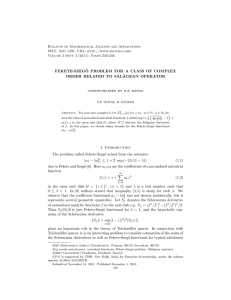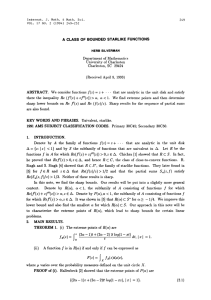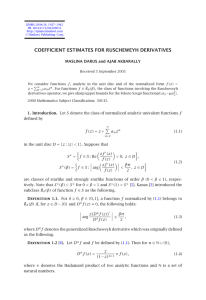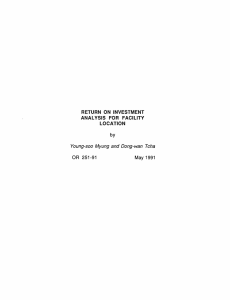Acta Mathematica Academiae Paedagogicae Ny´ıregyh´ aziensis 18 (2002), 63–65 www.emis.de/journals
advertisement
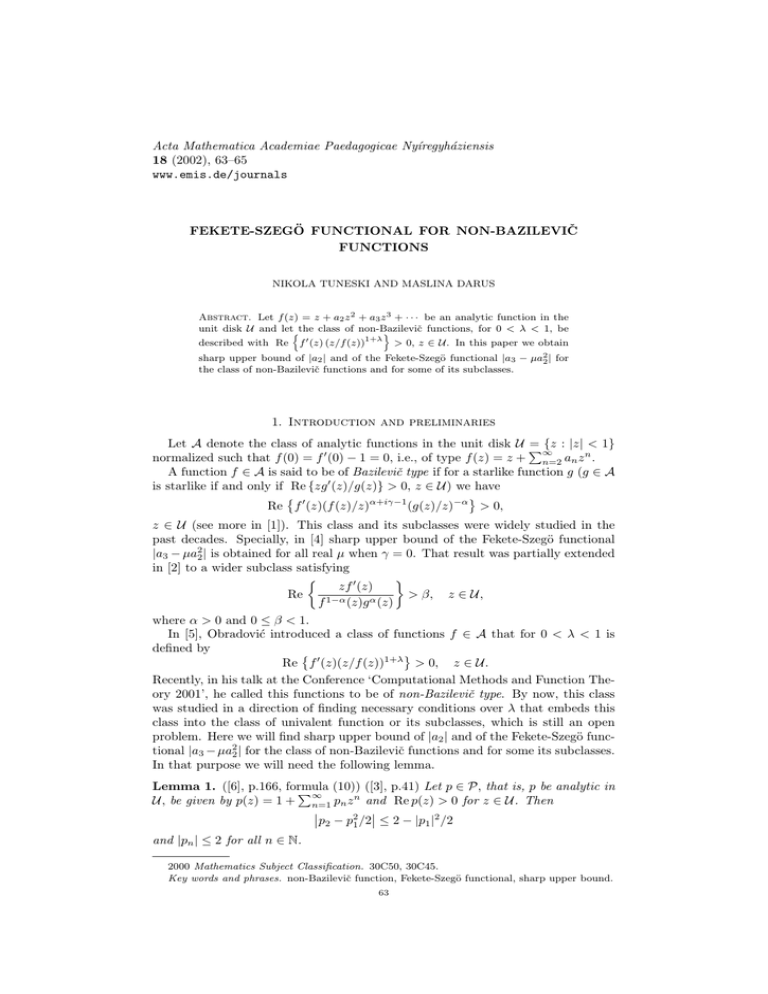
Acta Mathematica Academiae Paedagogicae Nyı́regyháziensis
18 (2002), 63–65
www.emis.de/journals
FEKETE-SZEGÖ FUNCTIONAL FOR NON-BAZILEVIČ
FUNCTIONS
NIKOLA TUNESKI AND MASLINA DARUS
Abstract. Let f (z) = z + a2 z 2 + a3 z 3 + · · · be an analytic function in the
unit disk U and letnthe class of non-Bazilevič
functions, for 0 < λ < 1, be
o
described with Re f 0 (z) (z/f (z))1+λ > 0, z ∈ U. In this paper we obtain
sharp upper bound of |a2 | and of the Fekete-Szegö functional |a3 − µa22 | for
the class of non-Bazilevič functions and for some of its subclasses.
1. Introduction and preliminaries
Let A denote the class of analytic functions in the unit disk U P
= {z : |z| < 1}
∞
normalized such that f (0) = f 0 (0) − 1 = 0, i.e., of type f (z) = z + n=2 an z n .
A function f ∈ A is said to be of Bazilevič type if for a starlike function g (g ∈ A
is starlike if and only if Re {zg 0 (z)/g(z)} > 0, z ∈ U) we have
Re f 0 (z)(f (z)/z)α+iγ−1 (g(z)/z)−α > 0,
z ∈ U (see more in [1]). This class and its subclasses were widely studied in the
past decades. Specially, in [4] sharp upper bound of the Fekete-Szegö functional
|a3 − µa22 | is obtained for all real µ when γ = 0. That result was partially extended
in [2] to a wider subclass satisfying
zf 0 (z)
> β, z ∈ U,
Re
f 1−α (z)g α (z)
where α > 0 and 0 ≤ β < 1.
In [5], Obradović introduced a class of functions f ∈ A that for 0 < λ < 1 is
defined by
Re f 0 (z)(z/f (z))1+λ > 0, z ∈ U.
Recently, in his talk at the Conference ‘Computational Methods and Function Theory 2001’, he called this functions to be of non-Bazilevič type. By now, this class
was studied in a direction of finding necessary conditions over λ that embeds this
class into the class of univalent function or its subclasses, which is still an open
problem. Here we will find sharp upper bound of |a2 | and of the Fekete-Szegö functional |a3 − µa22 | for the class of non-Bazilevič functions and for some its subclasses.
In that purpose we will need the following lemma.
Lemma 1. ([6], p.166, formula
P∞ (10)) ([3], p.41) Let p ∈ P, that is, p be analytic in
U, be given by p(z) = 1 + n=1 pn z n and Re p(z) > 0 for z ∈ U. Then
p2 − p21 /2 ≤ 2 − |p1 |2 /2
and |pn | ≤ 2 for all n ∈ N.
2000 Mathematics Subject Classification. 30C50, 30C45.
Key words and phrases. non-Bazilevič function, Fekete-Szegö functional, sharp upper bound.
63
64
NIKOLA TUNESKI AND MASLINA DARUS
2. Main results
Theorem 1. Let f ∈ A, 0 < λ < 1 and 0 ≤ α < 1. If
(1)
Re f 0 (z)(z/f (z))1+λ > α, z ∈ U,
then |a2 | ≤ 2(1 − α)/(1 − λ) and for all µ ∈ C the following bound is sharp
2(1 + λ − µ)(2 − λ)(1 − α) 2(1 − α)
|a3 − µa22 | ≤
max 1, 1 +
.
2−λ
(1 − λ)2
Proof. Condition (1) is equivalent to
f 0 (z) = (f (z)/z)1+λ [(1 − α)p(z) + α],
z ∈ U,
for some p ∈ P. Equating coefficients we obtain a2 = p1 (1 − α)/(1 − λ),
a3 =
(1 − α)2 (1 + λ) 2
1−α
p2 +
p1
2−λ
2(1 − λ)2
and further
a3 −
µa22
1−α
1 2
=
p 2 − p1 +
2−λ
2
(1 − α)(1 − λ)2 + (1 − α)2 (1 + λ − 2µ)(2 − λ) 2
+
p1 .
2(2 − λ)(1 − λ)2
Now, using Lemma 1 we receive |a3 − µa22 | ≤ H(x) = A + ABx2 /4 where x =
|p1 | ≤ 2, A = 2(1 − α)/(2 − λ) > 0, B = |C| − (1 − λ)2 /(1 − λ)2 and C =
(1 − λ)2 + (1 − α)(1 + λ − 2µ)(2 − λ). So, we have
H(0) = A,
|C| ≤ (1 − λ)2
2
|a3 − µa2 | ≤
.
H(2) = A|C|/(1 − λ)2 , |C| ≥ (1 − λ)2
Equality is attained for functions given by
1+λ
z
1 + z 2 (1 − 2α)
0
f (z)
=
f (z)
1 − z2
and
f 0 (z)
z
f (z)
1+λ
=
1 + z(1 − 2α)
1−z
respectively.
For α = 0 we have the following corollary.
Corollary 1. Let f ∈ A and 0 < λ < 1. If
Re f 0 (z)(z/f (z))1+λ > 0,
z ∈ U,
then |a2 | ≤ 2/(1 − λ) and for all µ ∈ C the following bound is sharp
2
(1 + λ − 2µ)(2 − λ) 2
|a3 − µa2 | ≤
max 1, 1 +
.
2−λ
(1 − λ)2
Now we will consider one subclass of the class of non-Bazilevič function.
Theorem 2. Let f ∈ A, 0 < λ < 1 and 0 < k ≤ 1. If
0
f (z)(z/f (z))1+λ − 1 < k, z ∈ U,
(2)
then |a2 | ≤ k/(1 − λ) and for all µ ∈ C the following bound is sharp
k
k(2 − λ) 1 + λ
2
|a3 − µa2 | ≤
max 1,
− µ .
2
(2 − λ)
(1 − λ)
2
FEKETE-SZEGÖ FUNCTIONAL
65
Proof. Similarly as in the proof of Theorem 1, condition (2) implies that there
exists a function p ∈ P such that for all z ∈ U
f 0 (z) = (f (z)/z)1+λ (2k/(1 + p(z)) + 1 − k).
Equating the coefficients we obtain a2 = −kp1 /(2(1 − λ)),
k
p21
k2 1 + λ 2
a3 =
p −
p2 −
8 (1 − λ)2 1 2(2 − λ)
2
and
k
p2
k 2 p21
1+λ
a3 − µa22 = −
p2 − 1 +
−
µ
.
2(2 − λ)
2
4(1 − λ)2
2
So, |a3 − µa22 | ≤ H(x) = A + Bx2 /4 where x = |p1 | ≤ 2, A = k/(2 − λ) > 0,
B = k 2 |C|/(1 − λ)2 − k/(2 − λ) and C = (1 + λ)/2 − µ. Therefore
H(0) = A,
|C| ≤ (1 − λ)2 /(k(2 − λ))
2
|a3 − µa2 | ≤
.
H(2) = Ak(2 − λ)|C|/(1 − λ)2 , |C| ≥ (1 − λ)2 /(k(2 − λ))
Here equality is attained for the functions given by f 0 (z)(z/f (z))1+λ = 1 − kz 2
1+λ
and f 0 (z) (z/f (z))
= 1 − kz, respectively.
For k = 1 we receive the following corollary.
Corollary 2. Let f ∈ A and 0 < λ < 1. If
0
f (z)(z/f (z))1+λ − 1 < 1,
z ∈ U,
then |a2 | ≤ 1/(1 − λ) and for all µ ∈ C the following bound is sharp
1
2 − λ 1 + λ
2
|a3 − µa2 | ≤
max 1,
− µ .
(2 − λ)2
(1 − λ)2 2
References
[1] I.E. Bazilevič. On a case of integrability in quadratures of the Loewner-Kufarev equation. Mat.
Sb., 37:471–476, 1955. Russian.
[2] M. Darus. Coeffitient problem for Bazilevič functions. J. Inst. Math. Comput. Sci. Math. Ser.,
2, 2000.
[3] P.L. Duren. Univalent functions. Springer-Verlag, 1983.
[4] P.J. Eenigenburg and E.M. Silvia. A coefitient inequality for Bazilevič functions. Annales Univ.
Mariae Curie-Sklodowska, 27:5–12, 1973.
[5] M. Obradović. A class of univalent functions. Hokkaido Math. J., 2:329–335, 1988.
[6] C. Pommerenke. Univalent Functions. Studia Mathematica Mathematische Lehrbucher. Vandenhoeck & Ruprecht, 1975. With a chapter on quadratic differentials by Gerd Jensen.
Received March 25, 2002.
Faculty of Mechanical Engineering, Karpoš II b.b.,
1000 Skopje, Republic of Macedonia
E-mail address: nikolat@ereb1.mf.ukim.edu.mk
School of Mathematical Sciences, Faculty of Sciencs and Technology,
University Kebangsaan Malaysia, Bangi 43600 Selangor, Malaysia
E-mail address: maslina@pkrisc.cc.ukm.my




